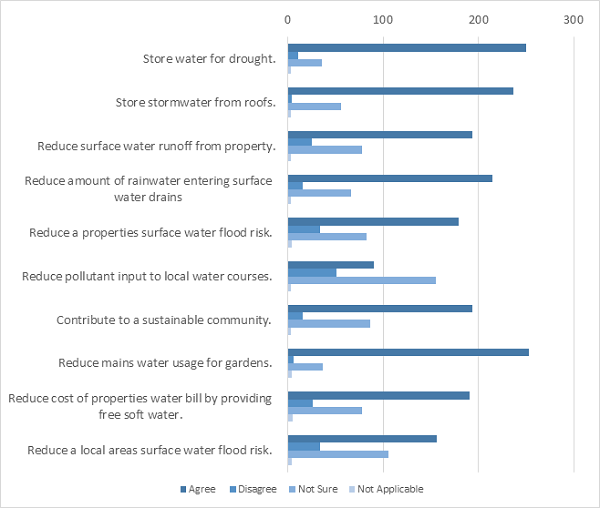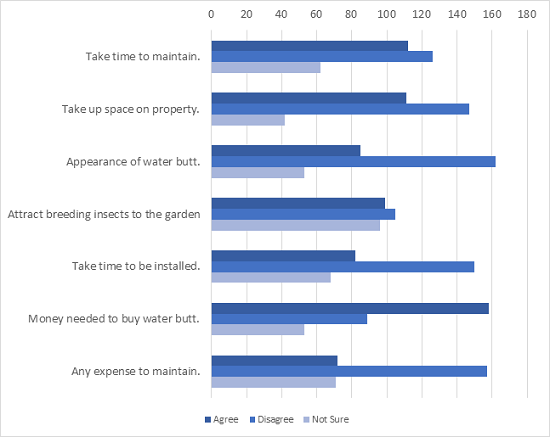
May 14, 2015, by Blue-Green team
Public Perceptions of Water Butt Usage for Flood Risk Management
As global urbanisation continues to occur, many urban areas are experiencing an increased risk from surface water flooding due to a reduction in permeable land and failure of surface water drainage systems (Lamond et al., 2012; Mitchell, 2012; CIRIA, 2012). In existing urban areas it can be hard to fit some of the more intensive sustainable urban drainage systems (SuDS), therefore, smaller cost effective systems such as water butts can be used to reduce local surface water flood risk.
Water butts can collect water from roofs of properties by being connected to a drainpipe coming down the side of the property allowing water butts to reduce the volume and velocity of runoff entering the local drainage system, helping to reduce surface flood risk both on an individual property and at a local level (Ahiablame et al., 2013; Carrington, 2014; CIRIA, 2012). For effective use of water butts as a mitigation technique, maintenance (i.e. regular emptying) is required by the water butt owners.
In 2014, I (Julia Parr, former Masters student at Cranfield University) undertook a study which aimed to investigate public perceptions of water butt usage for reducing surface water flood risk on the Wirral, a peninsula in North West England. There were three objectives for this research:
1) To understand current awareness and usage of water butts on the Wirral
2) To understand perceived advantages and disadvantages of water butt ownership
3) To understand how perception of surface water flood risk affects water butt usage
Results
The study showed 32% of respondents owned a water butt, however only 6.3% of respondents use their water butts to mitigate their surface water flood risk. Therefore, water butts are currently being used on the Wirral to mitigate surface water flood risk, however, in a very limited way. Many water butt owners on the Wirral do not use water butts to their full potential, however many have the potential to do so. The main barrier to the use of water butts for mitigating surface water flood risk seems to be a general lack of knowledge about water butts and their functions.
The top three perceived advantages of water butts were found to be that water butts can reduce mains water usage for gardens, store water for drought and store storm water from roofs. The top three perceived disadvantages of water butts were found to be the money needed to buy a water butt, the time needed to maintain the water butt and that they can take up space on the property.
A respondent’s age and housing status were seen to influence a respondent’s answer for whether they own a water butt, their views on advantages and disadvantages of water butts and their knowledge of previous surface water flooding. As seen in previous studies, a respondent’s knowledge and perception of surface water flood risk can affect their decision and willingness to take action to mitigate the risk.
This study showed a general lack of knowledge surrounding surface water flood risk and the ways water butts can be used to mitigate this risk. This study highlighted an interest in surface water flood risk by respondents and a willingness to learn more about the topic. This could be accomplished using several of the schemes that have been piloted in the USA (e.g. the Portland Downspout Disconnection Program), and adapting them for appropriate use in the UK.
This study highlighted that an effort should be made to promote awareness of local surface water flood risk and awareness of the benefits of water butts to the local community before trying to promote water butts as a management technique for surface water flood risk. This could be accomplished through the use of adverts in local free newspapers, or advice along with annual bin collection notices which many homeowners take notice of.
Further research is required into which techniques may be the most appropriate to help raise awareness of surface water flood risk and the use of water butts as a mitigation technique on the Wirral and to look into whether similar patterns can be seen elsewhere in the UK.
Blog post by Julia Parr based on her 2014 Masters Thesis “Public Perceptions of Water Butt Usage for Flood Risk Management” completed at Cranfield University in 2014.
References
Ahiablame, L.M., Engel, B.A., Chaubey, I. (2013) Effectiveness of low impact development practices in two urbanized watersheds: Retrofitting with rain barrel/cistern and porous pavement. Journal of Environmental Management, 119, pp.151-161.
Carrington, D. (2014) Beyond sandbags: how to protect a home from flooding. Available (15/5/14) at: http://www.theguardian.com/environment/2014/jan/10/how-to-protect-home-flooding.
CIRIA (2012) The SuDS manual. CIRIA C697. Accessed (28/08/2014) at: http://www.ciria.org/Resources/Free_publications/the_suds_manual.aspx.
Lamond, J., Wilkinson, S. and Rose, C. (2012) Conceptualising the benefits of green roof technology for commercial real estate owners and occupiers. In: 20th Annual Pacific Rim Real Estate Society Conference, 2014. Available (29/08/2014) at: http://eprints.uwe.ac.uk/22536/.
Mitchell, G. (2012) Gardeners make space for water. Available (27/05/2014) at: http://gardenchampions.leeds.ac.uk/wp-content/uploads/2012/05/19885_UoL_Water-Story.pdf.
No comments yet, fill out a comment to be the first



Leave a Reply